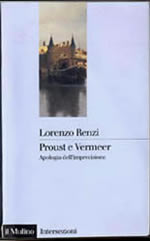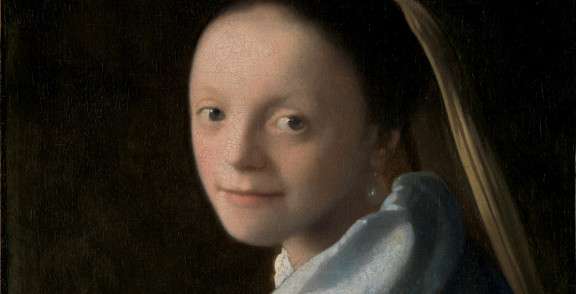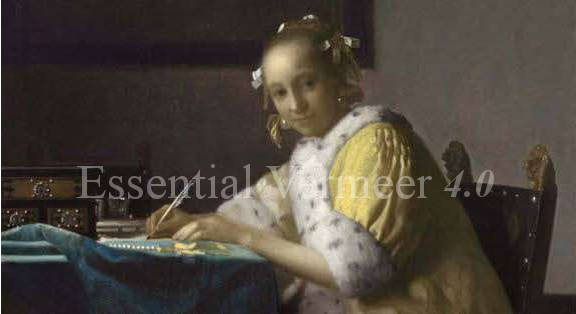Proust's À la recherche du temps perdu contains a passage in which the elderly writer Bergotte visits a Dutch art exhibit and, while examining a detail of Vermeer's View of Delft, falls ill and dies. That scene, that painting, that detail have attracted the attention of a multitude of critics. Lorenzo Renzi, author of Proust and Vermeer: An Apologia of Imprecision (Proust e Vermeer: Un Apologia dell'Imprecisionce, 1999, Mulino) offers a wealth of illuminating insights into the question.
Lorenzo Renzi teaches Romance Philology at the University of Padua. He is also the author of "Nuova introduzione alla filologia" (1994), "Come leggere la poesia" (1991); an a curator of "Grande grammatica italiana di consultazione" (3 vol. 1985–1995)
July 8, 2003

The Essential Vermeer: Would you be so kind as to briefly describe the problem you have addressed, your methods of investigation and your conclusion?
Lorenzo Renzi: In my book I have examined Marcel Proust's celebrated page of the "Recherche du temps perdu," the one dedicated to the death of the imaginary writer Bergotte while he was in front of the equally celebrated painting by Vermeer, the "View of Delft." In this scene Bergotte, in the last moments of his life, dies of a heart attack while he compares a detail of Vermeer's painting with the style he had used to write his own books: a style too dry, Bergotte thinks, arid compared to that of the splendid Vermeer detail. But which one is exactly the detail in question? Proust speaks of a "little yellow wall with a sloping roof." I sought in my essay to identify the celebrated little wall, firstly by interrogating critics and commentators of Proust (and also of Vermeer), then by accurately examining Vermeer's splendid picture on my own, through reproductions and direct observation of the painting. The results were uncertain, for critics have responded in different ways to the question. My personal conclusion is that Proust superimposed two details of the picture, a little roof flooded with sunlight ("yellow") within the right-hand side of the painting and two long but pale walls near the drawbridge toward the extreme right of the work, which Proust mistook for a roof. From these observations I arrived at Proust's lack of precision, a characteristic which does not contradict his genius. Rather, Proust's genius is revealed exactly in the particular deformation he impresses to things, just as in painting we could say of the impact of El Greco, Modigliani and many other artists.
How and when did you come about the initial idea for your investigation?
I have loved painting since I was a child, above all Italian Renaissance painting (I made my first visit to Florence when I was 13!), and as a reader, I have loved no author as much as Proust. However, my professional activity has been dedicated to linguistics and philology. Having admired the "View of Delft" at The Hague, I re-read Proust's page and wrote a few observations for myself. I then expanded upon them and began that research which my readers have often compared to a detective investigation. In reality, having never read any detective literature, I was inspired rather by methods used in linguistics. But this does not mean that detective investigation and linguistics do not have much in common, or even that they are not the same thing. I suspect it is so, even though I am not certain (in order to be sure I would have had to have read some detective stories).
What experience did you have with Vermeer's painting?
My love for painting was undifferentiated. I do not understand those who prefer Italian art to Flemish art or visa versa, those who appreciate the Baroque but not Neoclassicism. Born amid historicism, I try to understand and love all periods and all schools, and I believe I have succeeded (with the exception of English Victorian painting; there is a limit to everything). Having said this, Vermeer's work has always fascinated me particularly, above all for his figures which are so neat and precise, his famous photographic effect, and yet so superior to photography. The human eye is a photographic camera which knows how to choose, something the camera cannot do. I also admire Vermeer's capacity to represent middle-class intimacy, common to other Dutch painters beginning within Rembrandt, but which no other school of painting has known how to represent.
Did you begin the book with any particular thesis in mind or did you reach your conclusion after having examined the evidence you gathered? In your inquiry, did you encounter evidence which caused you to modify your ideas?
When I began writing the book I did not know how it would turn out—of this I am sure. But I do not very well remember when or how I found what would become the solution of the book, the solution which I have mentioned earlier. I remember that the research was fervid and that it required two trips to Paris where I combed book shops, visited the new Biblithèque nationale, and attempted to discover in oriental art museums just what "la Chinese preciousness"(which Proust attributes to the yellow wall) may have meant. I have not found an answer to this last question and in my book I had to recognize my failure. I did what a linguist, and what I believe scientists do when they do not have a sure answer to a problem, but are happy to offer to their public one or two hypotheses which are not completely absurd. Every research has its difficulties, but we cannot lie to our public about the certainty and comprehensiveness of our results.
The role of observation is of paramount importance in the works of both Vermeer and Proust. Which do you think are the similarities and differences in the way the two artists observe? What do you believe are the expressive ends which Proust's and Vermeer's work have in common?
It is not easy to compare a painter to a writer, to find similarities or differences. In any case, I believe that Proust and Vermeer are very distant from each other. Perhaps what Proust most admired in Vermeer was his capacity to assimilate in such an extraordinarily uniform and compact way everything he had painted. Everything which Vermeer paints, Proust thinks—apples, curtains, figures of women, walls and rays of light become Vermeer. "Ce n'est que du Vermeer," Proust would say. But after all, this could also be said of Picasso, Manet or Hopper. And so too with each writer's style, provided he has a style (but without a style, he would be a writer).
Why do you believe Proust chose specifically Vermeer's "View of Delft"?
Proust, son of his own age, of a city and of an environment among the most cultivated which had ever existed, was a great lover of art and painting, architecture as well as music. The "petire phrase" of Venteuil poses problems similar to those of the little yellow wall. It is probably a matter of superimposition (here too!) of Saint-Sans and Fauret. In painting, Proust, who admires the Impressionists (in Recherche Elstir, he substantially represents Monet), prefers representations of nature and landscape. By choosing the "View of Delft" for the scene of Bergotte, Proust demonstrated a predilection for the only view (and perhaps the first view he ever painted) of a painter who was essentially a painter of interiors.
It is known that in the "View of Delft" Vermeer made a number of alterations in his portrayal of the actual panorama he observed and it would seem he did so quite consciously. Do you feel that the imprecision you have revealed regarding Proust's "little patch of yellow wall" in Vermeer's painting was the fruit of casual and/or unconscious factors, or rather, as in the case of Vermeer, deliberate artistic intention?
I believe that what an artist does deliberately is less important than what he does instinctively without him being aware. You will say that this is paradoxical. But after all, it is logical that an artist above all does deliberately what the rules of his time impose, while the most important part of his work depends on internal impulses, unconscious, generally unknown even to the artist himself. A great artist is someone who allows those impulses to filter into his works, which instead his colleagues, too entangled and bounded by rules, hold too firmly within themselves. Although this is not the only explanation of an artist, it is also this which makes an artist great.
We know a great deal about the life of Proust, though we know, it would seem, proportionately little about the life of Vermeer. In your view, what significance does knowledge of an artist's life have in the process of understanding his work?
Proust believed that the life of an artist should be of no interest to us: only his work counts. The great philosopher Benedetto Croce was of the same point of view, and I grew up under his influence in the Italy of the 1950s and 1960s (I was born at the beginning of the Second World War in 1939). Probably Croce and other authors of the same persuasion are right. However, our curiosity about the authors whose works we read, admire or listen to is irrepressible. We want to know who there are, when they lived, who they loved (as Odette naively asked Swann, in Proust's novel: e...Odette c'est nous!) When literary criticism still did not exist, Sventonio, the anonimous vidas of the Troubadours and Vasari narrated the lives of the contemporary painters and writers as well as those of the past. Biographical interest, I believe, should not be condemned. But when we consider works of art, we must not permit that biographic knowledge to interfere in the formal observation of the work and lead us to a confusion of the two areas. Instead of an author's history, the knowledge of the events which surrounded him, the cultural environment in which he lived are useful, very useful, for understanding his work. An appendix: thanks to the scholar John Montias, we know quite a bit about Vermeer, this artist which Proust considered "à jamais inconnu," so much so that he believed that the artist, not by chance, had represented himself with his back turned to us in the "Art of Painting" in Vienna.
If you were at a dinner table with Proust and Vermeer, what would you like to ask them?
I would ask: How in the world did you get here together if you lived centuries apart? But, since here we are, what on earth can we talk about? Seeing that both of you are such eminent Europeans, I'd like to know your thoughts about Blair and Berlusconi at the head of important European countries. But you would probably not have the vaguest idea of what I am talking about.



